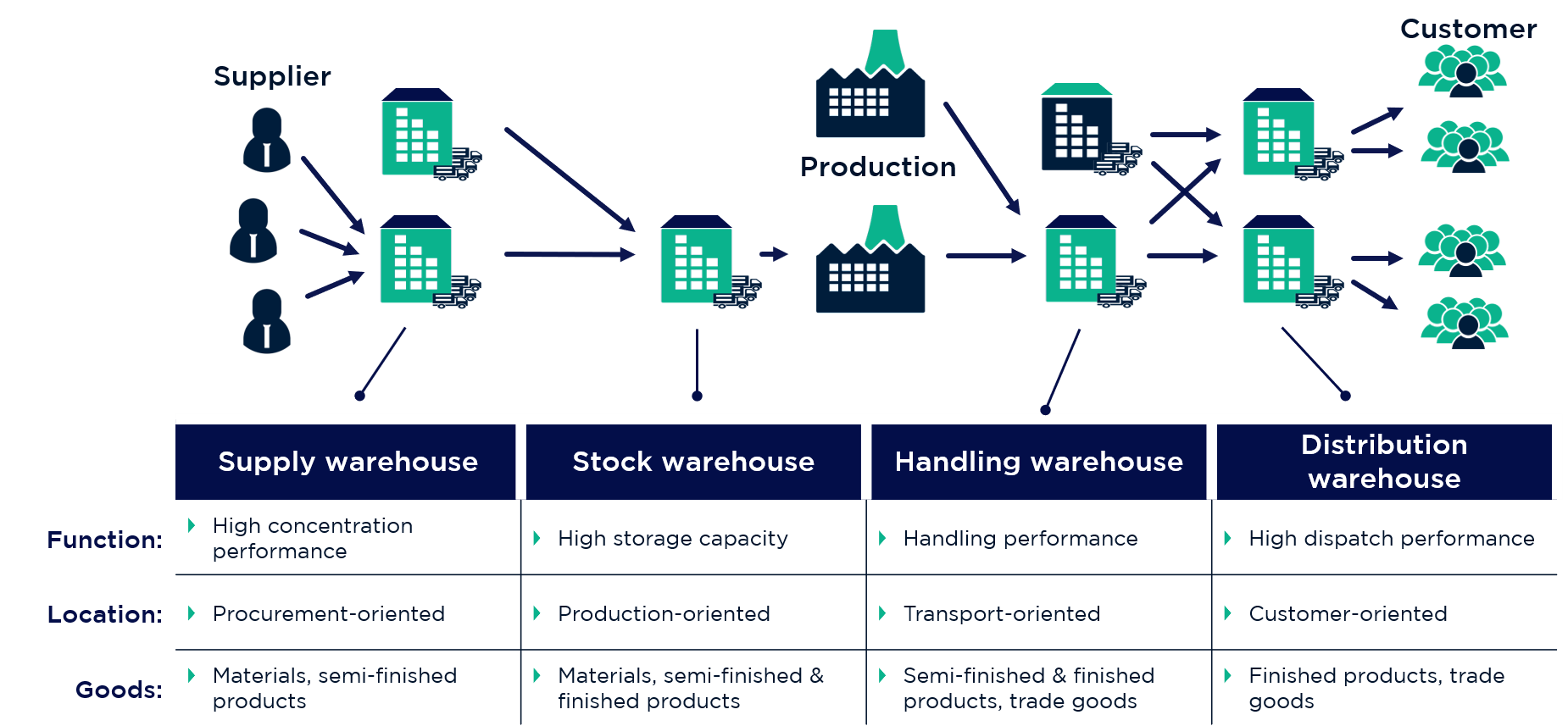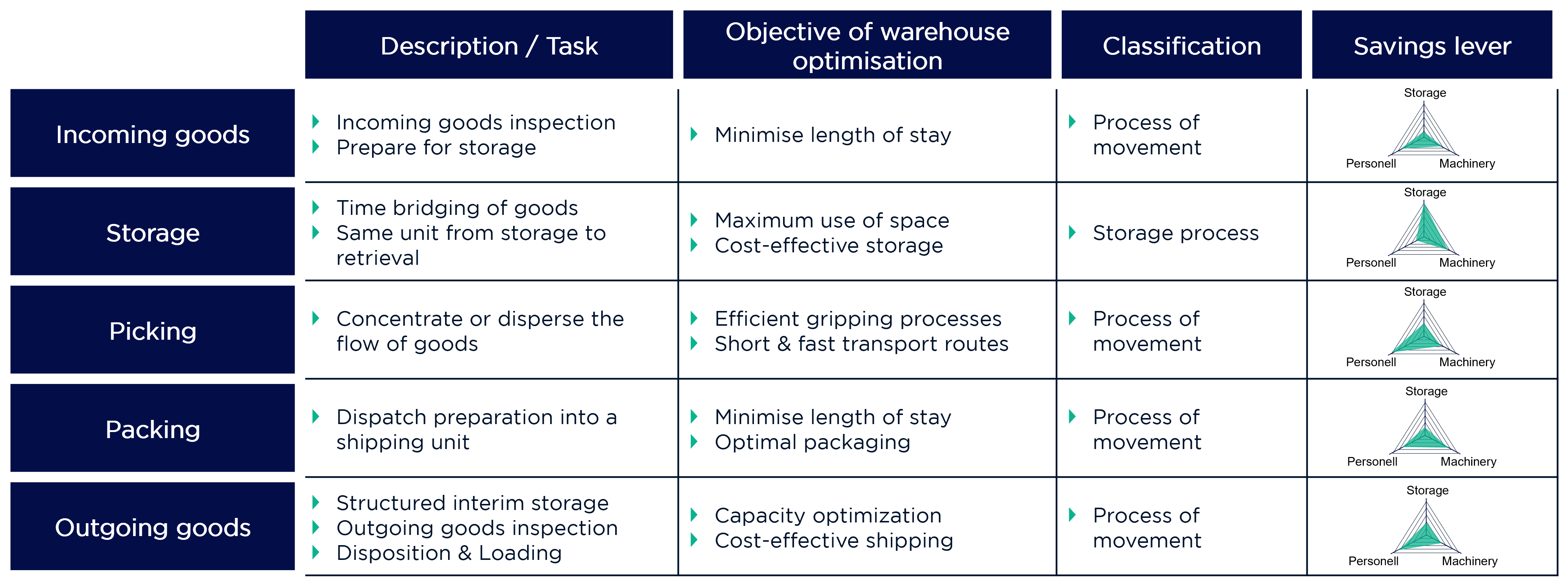
Warehouse planning & warehouse optimization: alignment, function, and layout of the warehouse
If you are planning a new warehouse or optimising an existing one, then you should ensure that the fundamentals of the warehouse – its alignment and function – are correct.
Most warehouse optimisation and warehouse planning initiatives are predominantly driven by operational needs, and concepts that have evolved over time are often adopted without questioning their current suitability. The structural decisions associated with a warehouse are capital-intensive and have great influence on the warehouse’s performance and costs. If you would like to learn more about how to realise the potential of an existing warehouse in a practical way, please read the section dedicated to our expertise in Fulfillment and Warehouse Logistics.
In the following section, we take a closer look at the most fundamental aspects of warehouse alignment, in the context of warehouse planning or warehouse optimisation through answering the following questions:
- What is the purpose of the warehouse – is it designed with its purpose in mind?
- What types of goods are to be stored – what type of warehouse is best?
- What function should each area of the warehouse perform?
- What does this mean for the warehouse layout and equipment?
- What philosophy for storage space allocation should be followed?
Warehouse type: What is the purpose of the warehouse?
During the warehouse planning or before a warehouse optimization initiative, there are two questions that should always be clarified first: What type of warehouse is it or should it be? What purpose should the warehouse fulfill? There are 4 types of warehouses, each of which serves a different purpose: the supply warehouse, the stock warehouse, the transshipment or handling warehouse, and the distribution warehouse. The warehouse types can also be mixed, but in any case it is important to be clear about the function, the storage requirements, and the goods to stored. These aspects need to be taken into account throughout warehouse planning or warehouse optimization initiatives.

Explanation of the differences based on 2 examples:
- A supply warehouse is able to maintain a high storage capacity for goods used in production. For the warehouse dimensions and structure this means, for example, an increased need for storage capacity and rather large-volume material flows. Also, the focus on process speed is usually lower since the demand is much more predictable due to predefined production plans.
- A handling warehouse, which is mainly found in logistics and retail, is defined primarily by its transshipment performance. Fast processes, relatively small bundle sizes, an often-higher product variety, and greater order individuality usually increase the need for manual processes and, above all, movements within the warehouse.
In case of ambiguity, it is recommended to discuss the 4 warehouse types in the planning committee or warehouse optimization project team. Thus, the long-term purpose of the planned or existing warehouse can be defined and the objectives for warehouse replanning or warehouse optimization derived.
Types of goods and their importance for the warehouse type
The dimensions and layout of a warehouse depend not only on the type of storage, but also on the type of goods to be stored. This in turn influences the possible types of storage and the storage infrastructure. Goods are differentiated in many different ways, including: material, weight, consistency, volume, the quantity to be stored, consumption units, value, storage condition requirements, hazardousness, shelf life, sensitivity, and turnover rate.
In many warehouses, the types of goods in the product assortment differ. Although on some plots of land, or even in the same building, different types of warehouses can be combined, as a general rule, it is necessary to find the optimal type of warehouse for the product assortment, taking into account the available space and capital investment. The types of warehouses differ based on their construction. Typical types of warehouses are: open storage, tiered storage, flat storage, high-bay storage, tank storage, and load-bearing storage.
If the goods and products of a warehouse change over time, if a warehouse was never designed according to the type of goods to be stored, or if you are in the process of planning a new warehouse, the type of goods and the volume of expected goods should be discussed with the supply chain team and management to be taken into account for the consideration of the type of warehouse.
Warehouse function: What are the objectives of each warehouse area?

Once the purpose and the type of the warehouse have been defined, it is necessary to consider the storage areas. The storage areas differ in principle according to their task, goal, or process classification.
The definition of the requirements and objectives for each storage area is the next important step before figuring out the dimensions and layout of a warehouse.
For this, the purpose of the warehouse, the type of warehouse, and the type of goods or product assortment must be applied to the individual warehouse areas. For each storage area, it is necessary to develop an understanding of what is required to perform the task and achieve the objective of the storage area. This involves capacity, throughput rates, capital investment, and personnel deployment per storage area, but, most importantly, the arrangement of storage areas within the warehouse. Material flow should definitely be taken into account when deciding on the warehouse layout in order to make transport routes short and reliable.
If you are unsure whether the warehouse function has been sufficiently considered during the warehouse planning stage, we recommend a workshop involving the operational and strategic supply chain managers as well as an expert in the field of warehouse optimization and warehouse planning.
Warehouse equipment: How will the warehouse be designed?
Based on the availability of space, capital, and time, once the criteria of storage type and storage function have been determined, the warehouse can now be designed in terms of the equipment it employs. The first step is to work out the possible options for each storage area. Here are some examples:
- Fixtures in the form of shelving systems, containers, picking stations, incoming and outgoing goods systems, etc.
- Material handling equipment in the form of forklifts, conveyor belts, cranes, stacker cranes, lift trucks, transport carts
- Load containers such as pallets, barrels, containers, bags
- IT systems such as warehouse management systems, scanners, sensor systems
- Organisational arrangements e.g. storage location allocation etc.
The possible design options can then be evaluated and selected with regard to their respective size requirements per storage area as well as the performance with regard to the required target criteria.
In practice, the freedom with which the options can be considered depends to a large extent on whether it is a question of planning a new warehouse on a "greenfield site" or whether the restrictions of existing building structures have to be taken into account.
Storage location allocation: Which storage location allocation philosophy should the warehouse pursue?
Another question to consider in warehouse planning or warehouse optimization is that of the storage location allocation philosophy. Typically, this philosophy is determined within the scope of the warehouse design, or immediately downstream of it.
When answering this question, the restrictions described above, which result from the type of goods and the warehouse layout, must be taken into account. For example, some types of goods require that they be spatially separated from other goods because, for example, odor sensitivity or hazardous substance classes prohibit joint storage.
The storage location allocation can follow two opposing approaches: A fixed storage slot assignment or a completely free – or "chaotic" – storage system. Between the two extremes, there exist hybrids, two of which are described in the figure below.
Which philosophy is appropriate for the warehouse depends largely on the goods or article portfolio as well as the associated fluctuations and the optimisation maxim.
For example, a fixed storage slot assignment is suitable for item assortments that are stable in terms of demand and item types, with clear movement patterns such as a consistent differentiation between fast-moving, medium-moving, and slow-moving items. The influencing factors to be considered here are path length, turnover frequency, value, weight, access frequency, volume and dimensions. In this philosophy, the optimisation maxim is usually to reduce distances and thus speed-dependent costs.

Chaotic warehousing is particularly suitable when the assortment and the demand fluctuates and no fixed order pattern for the items can be observed. This philosophy is used, for example, by Amazon in order to utilise warehouse capacities and because the item assortments are diverse, fluctuating, and ever-changing. An essential prerequisite for this is the seamless use of electronic data processing to monitor and control stock levels and item locations. During picking, the picking personnel are often guided by an IT solution e.g. via mobile scanner terminals or audio devices (pick-by-voice). Storage location allocation can be controlled by algorithms in such a way that data correlations of orders as well as distances between individual articles are included in route optimisation.
The challenge of the planning horizon and desicion-making momentum
The opportunities to set the right course in the long term with appropriate warehouse planning and warehouse optimization are rare. The necessary momentum is rarely found due to the topic’s long-term nature and a lack of available investment funds. Often companies do not think long-term enough to recognise and want to realise the added value of warehouse planning or warehouse optimization.
Experience shows that in many cases this decision is made incorrectly and the added value and opportunities are traditionally not examined thoroughly enough.
If a window opens in which such an investigation and decision is possible, you should seize it. Particularly if warehouse planning has not been approached strategically or if the usage and/or assortment have changed significantly since the planning phase, there is often a large amount of room for improvement in both warehouse costs and performance. Too many times, a transparent and analytically verifiable case for investment is not adequately constructed and the opportunity is missed.
Conclusion on warehouse planning and warehouse optimization
Warehouse planning as a decision-making process is far-reaching and has a large impact on the cost and performance of the warehouse. To maximise the contribution of the warehouse within the supply chain and towards the company's success, the following points should be considered:
- The type of warehouse and its purpose are key to forming the target criteria against which the warehouse should be planned and its performance measured and managed
- The warehouse type and function of the individual warehouse areas are based on these target criteria and inform the specifications for the design, setup, and warehouse processes
- The warehouse layout and equipment, as well as the philosophy of storage location allocation implement the specifications of the individual storage areas
If you optimally align your warehouse using these fundamental concepts, your warehouse will contribute to the success of your supply chain for many years to come. Be sure to ask yourself if you have sufficiently challenged and reviewed the alignment of the warehouse as part of a warehouse planning or warehouse optimization initiative. Too many logistics specialists have to live with the consequences of bad planning for years and can only carry out downstream optimization initiatives within a rigid structural framework, often with limited impact.
OCM offers you support in the analysis, evaluation, realisation, and implementation of your warehouse planning initiative:
- Warehouse Optimization and Warehouse Logistics
- Supply Chain Network Design
- Inventory and Order Quantity Optimisation
- Supply Chain & Logistics Opportunity Assessment
- eSCM and Logistics Digitalisation
You will find further modules in our comprehensive product offering Supply Chain & Logistics.
We would be pleased to present our approach and modules to you or to discuss concrete solutions to your warehouse planning and warehouse optimization challenges.

Logistics optimisation & Supply Chain Consulting modules
Logistics & SCM Opportunity Assessment
- Benchmarking & maturity testing
- Identification of opportunities & action plan
Transport Partner Management
- Transport partner strategy & professionalisation
- Securing resources and resource training design
Transport Tender
- Competition, effective transport tendering, fact-based negotiation
- Transport cost reduction
Freight & Logistics Tender
- Competitive pricing, quality, and performance assurance
- Individual weight-distance matrix
Warehouse Optimisation
- Efficient warehouse logistics & layout
- Optimised processes & working capital
Logistics Cooperation
- Optimising logistics through synergies
- Finding a fair and stable collaboration model
Route Optimisation
- Distance and route reduction
- Reduce resource & logistics costs
Supply Chain Network Optimisation
- Optimise delivery times, service levels, & processes
- Reduce working capital
Inventory & Order Management
- Optimal order quantity & stock on hand
- Optimise working capital
Fleet Optimisation
- Fleet concept tailored to requirements
- Cost optimisation
Supply Chain & Logistics Strategy
- Sustainable maximum value contribution of the supply chain
- Clear objectives, concrete measures
Digital Logistics Management & Reporting
- Information advantages in speed, scope, & significance
- Efficiency through automation, data integration & process simplification
Interim Supply Chain & Logistics Manager
- Rapid response: candidates within 48h
- Matching of requirements and assessment of suitability using logistics experts
- From dispatcher to logistics manager
Short-term staff shortage? Unexpected need for action?
Learn more